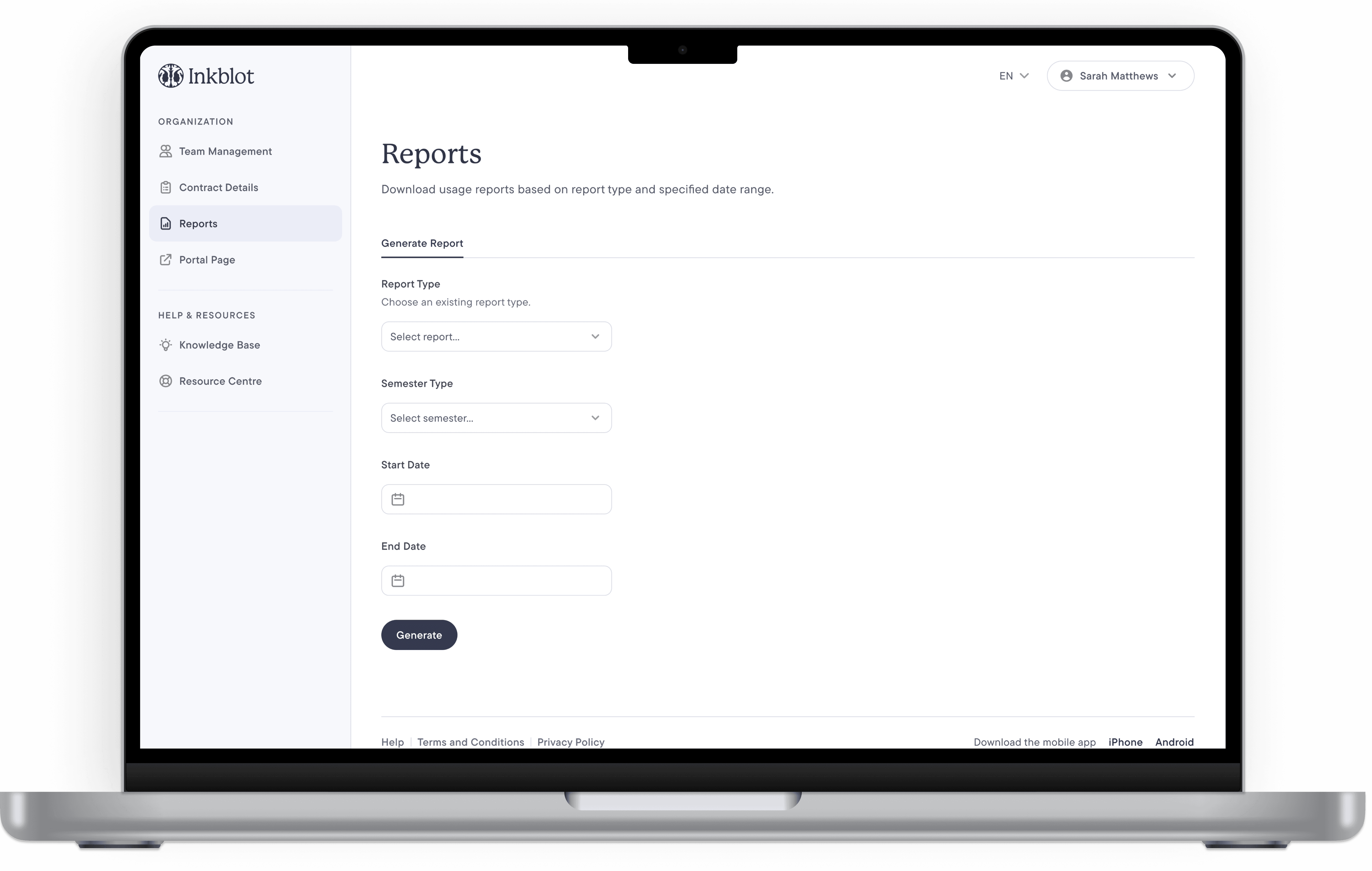Inkblot Management
An employee management platform designed to help Human Resources and Administration teams manage their employee’s benefits access.
Inkblot offers accessible and effective mental health solutions for individuals and organizations. Being a digital-first employee wellness program, Inkblot wanted to create a separate external product independent of Inkblot Therapy for Human Resource managers and Administration teams to manage their employee programs and view or modify their contract details. Learn more at Inkblot Therapy.
Request Full Case Study →
—————————————————
Problem Space
Manual Bottlenecks: The Account Management team relied heavily on manual processes to handle client accounts, which worked initially but became inefficient as the client base expanded.
Scaling Challenges: As daily requests grew, the team struggled to keep up. This lead to delays, errors, and an unsustainable workload that limited their ability to provide proactive support.
Data & Privacy Risks: Managing sensitive client data through fragmented, manual methods (Microsoft Excel) introduced potential privacy concerns and highlighted the urgent need for a more secure, automated system.
Organizational Desire
Empowering Clients: The goal was to design a self-service platform that enables clients to independently manage their day-to-day needs without relying on the Account Management team for everyday tasks.
Enhancing Privacy & Control: By giving clients direct ownership of their sensitive data, the platform aimed to strengthen privacy, transparency, and trust.
Reducing Operational Load: Shifting routine tasks to a secure, client-facing portal would significantly reduce the manual workload on the Account Management team, thus allowing them to focus on strategic, high-value support.
Key Research Considerations
The research combined primary and secondary methods to uncover user needs and industry context. Internal interviews with Product and Account Management teams, along with external client interviews and pain-point workshops, revealed key challenges and opportunities. Prototyped concepts were then usability-tested to validate early ideas. Complementing this, competitor analysis, heuristic evaluation, and exploration of similar tools through free trials helped identify best-practice patterns and inform a scalable design approach.
Understanding the Users: The first step was to identify who would interact with the platform daily. The primarily client administrators and account managers. The goal was to uncover their specific requirements, frustrations, and workflow challenges.
Defining Core Needs: The research focused on what users needed to accomplish most often, pinpointing key tasks and functionality essential for managing accounts, data, and day-to-day operations efficiently.
Mapping Current Behaviours: By analyzing how clients currently handled these tasks (often through manual emails, spreadsheets, or direct AM support), the process revealed major pain points around inefficiency, inconsistency, and lack of visibility.
Research Findings
Research revealed major inefficiencies in manual account management, with clients frustrated by slow, error-prone workflows reliant on Inkblot’s internal team. These insights shaped the platform’s priorities—empowering clients through autonomy, transparency, and scalable management tools.
Operational Issues Identified:
Employee Management Gaps: When clients onboard new employees, they must email Inkblot’s Account Management team to manually update Excel sheets and the back-end. This process often leads to errors due to differing start dates, time zones, bulk additions, and terminations, all resulting in in missed updates and inaccurate reporting.
HR Onboarding Inefficiencies: When new HR managers join, their onboarding is handled manually through email, causing lost credentials, overlooked access changes, and limited client control over account permissions.
Key Feature Themes Requested:
Team Management Workflows: The ability to add or remove employees (individually or in bulk) directly within the platform.
Contract Management Tools: Admins wanted self-serve access to view and modify contract details without relying on the Account Management team.
Automated Reporting: A quick, customizable way to generate and download usage reports, replacing the slow, manual email-based request process.
Design Response
Building on the research insights, the goal was to transition from a reactive, email-driven process to a proactive, self-serve platform, streamlining operations for both clients and the Account Management team.
Empower, Don’t Depend: Equip clients with a platform to independently manage employees, contracts, and reports.
Transparency Through Visibility: Provide clear access to account data, user status, and reporting dashboards to eliminate ambiguity and prevent errors. Make the platform easy to learn and empower new users.
Design for Scale: Create flexible workflows that accommodate bulk actions, varied access levels, and organizational changes without administrative bottlenecks.
Privacy by Design: Ensure sensitive client and employee data is securely managed with role-based permissions and clear audit trails.
Consistency & Usability: Establish reusable design patterns that make complex enterprise workflows intuitive and consistent across the platform.
Results
73% Reduction in Client Requests: Within the first quarter post-launch, daily requests to Account Managers dropped significantly, freeing the team to focus on strategic support.
4.5★ Client Satisfaction Rating: Post-launch surveys reported an average 4.5 out of 5 satisfaction score, reflecting improved usability and client autonomy.
88% Faster Client Onboarding: The new scalable platform streamlined setup workflows, reducing onboarding time and accelerating client adoption.
Final Screens




Project Learnings
Adapting Fast: This project strengthened my ability to quickly learn a new industry from the ground up, understanding its language, regulations, and workflows to design with credibility and context.
Facilitating at Scale: Hosting multiple workshops and interviews, including large 20+ participant sessions, built confidence in managing group dynamics, guiding discussions, and extracting meaningful insights from diverse stakeholders.
Mastering the Problem Space: It reinforced that the real work (and the most value) lies in deeply exploring the problem space. The more time spent understanding user pain points, workflows, and context, the more naturally the solution emerges. By the time design began, clarity made the execution feel almost effortless.
Research as the Foundation: The experience proved that solving complex problems becomes far simpler once the root issues are fully understood. Research isn’t a phase, it’s the backbone of effective design.
Clarity Through Collaboration: Working across teams and departments highlighted how structure, clear facilitation, and well-framed discussions can align even the most complex groups toward a shared vision.
